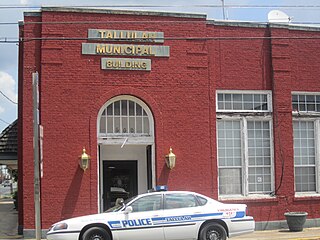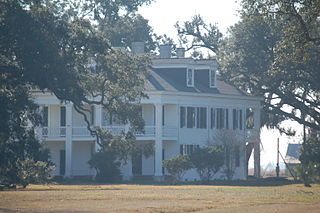
Tensas Parish is a parish located in the northeastern section of the State of Louisiana; its eastern border is the Mississippi River. As of the 2020 census, the population was 4,147. It is the least populated parish in Louisiana. The parish seat is St. Joseph. The name Tensas is derived from the historic indigenous Taensa people. The parish was founded in 1843 following Indian Removal.

Concordia Parish is a parish that borders the Mississippi River in eastern central Louisiana. As of the 2020 census, the population was 18,687. The parish seat is Vidalia. The parish was formed in 1807.

Lake Providence is a town in, and the parish seat of, East Carroll Parish in northeastern Louisiana. The population was 5,104 at the 2000 census and declined by 21.8 percent to 3,991 in 2010. The town's poverty rate is approximately 55 percent; the average median household income is $16,500, and the average age is 31.

Tallulah is a city in, and the parish seat of, Madison Parish in northeastern Louisiana, United States. As of the 2020 census, the population was 6,286, down from 7,335 in 2010.

Newellton is a town in northern Tensas Parish in the northeastern part of the U.S. state of Louisiana. The population is 1,187 in the 2010 census, a decline of 255 persons, or 17 percent, from the 2000 tabulation of 1,482. The average age of the population there is 41 years.

St. Joseph, often called St. Joe, is a town in, and the parish seat of, rural Tensas Parish in northeastern Louisiana, United States, in the delta of the Mississippi River. The population was 1,176 at the 2010 census. The town had an African-American majority of 77.4 percent in 2010.

The Tensas River is a river in Louisiana in the United States. The river, known as Tensas Bayou in its upper reaches, begins in East Carroll Parish in the northeast corner of the state and runs roughly southwest for 177 miles (285 km) more or less in parallel with the Mississippi River. The confluence of the Tensas and the Ouachita rivers, in Jonesville in Catahoula Parish, creates the Black River, not to be confused with Black Lake in Natchitoches Parish in north-central Louisiana.

The Hard Times Plantation is located in Tensas Parish, Louisiana and was used as a staging area by the Union Army in the Vicksburg Campaign. At the time of the Vicksburg campaign, Hard Times was owned by Dr. Hollingsworth.

The Tensas Parish School Board is an entity responsible for the operation of public schools in Tensas Parish in northeastern Louisiana, United States.

Grace Episcopal Church is an historic Episcopal church located at St. Francisville, West Feliciana Parish, Louisiana. The congregation was organized in 1827. The present church was completed in 1860, but it was heavily damaged by Union gunboats in 1863, during the Civil War.

U.S. Highway 65 (US 65) is a part of the United States Numbered Highway System that spans 966 miles (1,555 km) from Clayton, Louisiana to Albert Lea, Minnesota. Within the state of Louisiana, the highway travels 100.77 miles (162.17 km) from the national southern terminus at US 425/LA 15 in Clayton to the Arkansas state line north of Lake Providence.
Routh Mounds is a Plaquemine culture archaeological site in Tensas Parish, Louisiana. It is the type site for the Routh Phase(1200 to 1350 CE) of the Tensas Basin Plaquemine Mississippian chronology. It is located approximately 2 miles (3.2 km) northwest of the Winter Quarters State Historic Site.
Samuel Winter Martien was a wealthy cotton planter who served as a Democrat from 1906 to 1920 in the Louisiana House of Representatives from his adopted Tensas Parish in northeastern Louisiana.
Thomas Magruder Wade, I, was an educator, politician, and civic leader from Newellton in Tensas Parish in northeastern Louisiana.
Clifford Cleveland Brooks, also known as C. C. Brooks, was a Georgia native who served as a Democrat from 1924 to 1932 in the Louisiana State Senate. Brooks represented the delta parishes: Tensas, Madison, East Carroll, and Concordia, a rich farming region along the Mississippi River in eastern Louisiana ranging from Vidalia to Tallulah to Lake Providence. At the time, two state senators served from the four-parish district.
Clyde Vernon Ratcliff, Sr., was an American cotton planter and politician from Newellton, Louisiana, who served as a Democrat from 1944 to 1948 in the Louisiana State Senate. He represented the delta parishes: Tensas, Madison, East Carroll, and Concordia, a rich farming region along the Mississippi River in eastern Louisiana ranging from Vidalia to Lake Providence. The four parishes elected two senators at the time, and Ratcliff's seat-mate was Andrew L. Sevier of Tallulah in Madison Parish.
George Henry Clinton was a chemist, lawyer, and Democratic politician from St. Joseph in Tensas Parish in the northeastern Mississippi River delta of the U.S. state of Louisiana.

Felicity Plantation is a historic sugarcane plantation on the banks of the Mississippi River in the U.S. state of Louisiana. It is located along Louisiana Highway 18 in Vacherie, St. James Parish. Felicity is a sister plantation to St. Joseph Plantation, and was built around 1846 by Valcour Aime as a wedding gift to his daughter, Felicite Emma, and her spouse, Septime Fortier, who was also her cousin. Acquired by a bank in 1873, the plantation was purchased by Saturnine Waguespack in 1890, who merged it with the St. Joseph Plantation to form the St. Joseph Plantation and Manufacturing Company. The house still remains in the Waguespack family.

Lansdowne is a historic estate that is listed on the National Register of Historic Places in Natchez, Adams County, Mississippi. The mansion was originally built as the owner's residence on a 727-acre, antebellum, hunting estate - like the estates of the landed gentry in England. The home and one hundred and twenty acres of the original estate are still owned and occupied by the descendants of the builder, who open it periodically for tours.
















